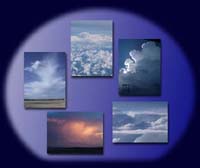Contrails |
|
| Contrails | |
| Contrail Shadows | |
| Distrails | |
| Sky with Contrails | |
| Contrails at Wings | |
| Overview | |
Contrails
|
Processes.jpg: This graph illustrates the processes which are responsible
for the development of contrails. The hot exhaust gases of the engines
are isobarically mixed with the cold surrounding air. The released
sulphuric acid vapour condenses on soot particles which are also
emitted. So droplets consisting of liquid sulphuric acid are formed
on a soot particle core by heterogenous nucleation. However under
certain conditions gaseous sulphuric acid can also directly form
sulphuric acid droplets via homogenous nucleation. In addition clusters
of charged molecules in the exhaust gas support droplet formation.
Once the droplets are generated, they will grow by absorption of
water vapour molecules (condensation). If the air is cold and humid
enough, the droplets can grow to large sizes and freeze to ice particles.
Only now the contrail becomes visible. Contrails1-4.jpg: The images which were taken from the ground show
different stages of a contrail. The numeration fits with the temporal
sequence of around 20 minutes. Contrails5.jpg displays a sky with long contrails. This indicates high humidity at an altitude of approximately 10 to 12 km. Here the supersaturation is high enough to prevent ice-particles which have been once formed in the contrail to evaporate for a longer period of time. Contrails6+7.jpg present contrails which are momentarily formed
behind the aircrafts. They were generated in dry air and thus quickly
evaporate so that they are very short. In the images the long, broad
ice-cloud stripes are "aged contrails" occurring in a
humid air layer. |
Contrails with different lengths often appear next to each other.
This indicates a layering of air masses with significantly varying
humidity in the upper troposphere. The stripy structure of the broad
contrail in Contrail7.jpg is caused by sedimentation of large ice
particles from the clouds top down in an air layer with shear flow. Contrails8.-10.jpg: Different stages of a contrail, observed from
the ground. In contrast to Contrails1.jpg these images show a contrail
which quickly (in around 10 min) evaporates above an Altocumuls
translucidus layer. The contrail occurs in a region of strong horizontal
wind shearing. Therefore it has a clearly visible wave structure.
Contrails11-.14.jpg: Some more contrails in the upper troposphere which is supporting ice particle formation are shown here. For Contrails14.jpg a 200 mm objective was used with an exposure time of 1/13 s. During this period of time the aircraft moves 17 m forward. Therefore it is obvious why the reproduction is only blurred. A large-capacity jet which has started at Frankfurt Airport in
a distance of 40 km is displayed in Contrail15.jpg. The aircraft
was pictured with a 200 mm objective from the ground. |
Passing1-4.jpg: Processes.jpg: J. Curtius, Mainz, Germany, May 2002 Passing1-4.jpg: S. Borrmann, flight from Frankfurt to Philadelphia,
6 December 2004, 6:49:56 p.m. to 6:56:07 p.m. |
![]()























